May 2nd, 2017 by IISG
St. Elmo Brady STEM Academy welcomed two IISG specialists to their roster of teachers recently.
Climate Specialist Molly Woloszyn and Education Coordinator Terri Hallesy carried on in the spirit of the academy by sharing their expertise with underrepresented fourth- and fifth-grade students in the Champaign, Illinois area.
The program was developed in 2013 by Ricky Greer, a K-12 education specialist, and Dr. Jerrod A. Henderson, a University of Illinois lecturer in Chemical and Biomolecular Engineering (CHBE). Its name, St. Elmo Brady, honors the first African-American student to earn a PhD in chemistry in the United States in 1916. Although the program is housed in CHBE, it’s meant to introduce students to a range of STEM disciplines.
Woloszyn and the students toured the weather station with Jim Angel, the Illinois state climatologist. She also did an activity that demonstrated air pressure – the collapsing can. She then taught them how to make a rain gauge from a 2-liter bottle that they could take home.
“I had a really great time doing this event,” Woloszyn said. “It was really fun to interact with the students and see them be so interested in making the rain gauge.”
Hallesy spent her time with the students talking about the role aquatic invasive species play in altering the Great Lakes basin ecosystem. She used fun games like “Stop Asian Carp in their Tracks” and “Nab the Aquatic Invader,” to explain how students by making simple changes, like properly disposing of a pet fish, can do their part in helping to prevent the spread of AIS.
“I see them as agents for change in their community. The kids were so interested in learning about what they could do to help,” Hallesy said. “They loved it!”
Program director Joe Gamez has seen the positive impact the program has had on the students.
“Without this exposure, minorities and girls think, ‘Oh, this this is not for me. This is for other people. Other people do that kind of stuff,’” Gamez said.
“But when they get exposure to it, it changes the way they look at things. The exposure the children get to these STEM topics from people who are so knowledgeable and passionate has really made a difference.”
August 8th, 2016 by iisg_superadmin
Nutrients that flow into lakes and streams from urban and rural environments are a key cause of algal blooms, which can then crash into low-oxygen ‘dead zones.’ In fact, Illinois, with its many acres of farmland and its major municipalities, is a key contributor to nutrient pollution in the Gulf of Mexico. Researchers at the Illinois State Water Survey set out to better calculate nutrient levels in waterways, the dynamics of when nutrient pollution happens, and what this means in the face of a changing climate.
With support from Illinois-Indiana Sea Grant (IISG), hydrologist Momcilo Markus and his team looked at years of data from 14 rural and suburban watersheds in Illinois, Indiana, and Ohio to get a better understanding of the factors that influence pollution rates.
The project is part of a larger regional effort to understand the science behind nutrient pollution and develop management strategies based on the findings. This effort is being led by University of Illinois Extension, Prairie Research Institute, Illinois Environmental Protection Agency (Illinois EPA), Illinois Department of Agriculture (IDOA), Illinois Water Resources Center, and IISG.
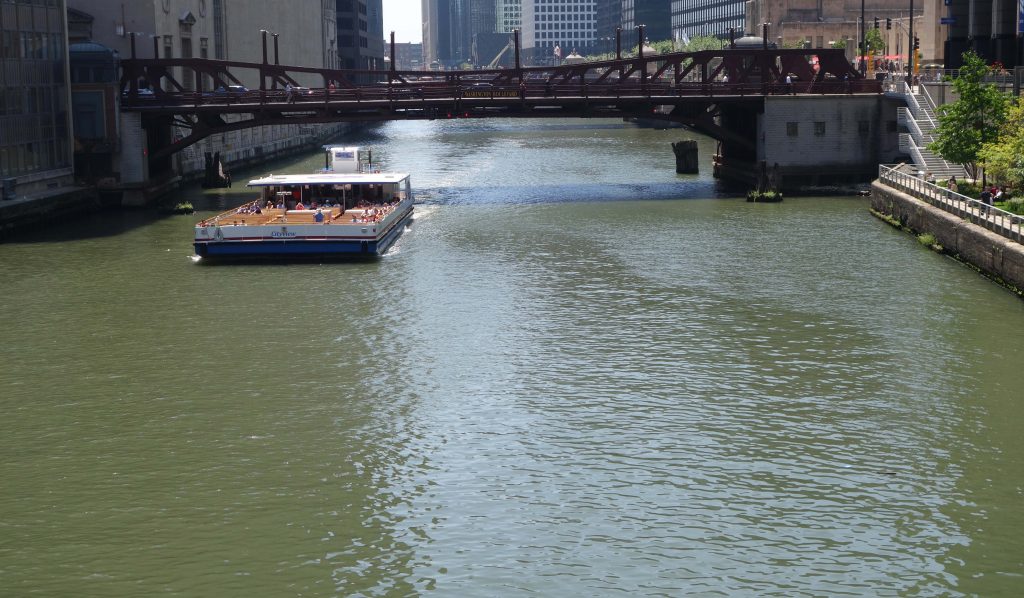
Markus’ work improved the accuracy of estimating nutrient loading from limited monitoring data. Typically, for most waterways, monitoring is infrequent—several data points are extrapolated for a year. The researchers used a rich Ohio data source where there is as much as 38 years of daily measures from 10 streams. This served as a Rosetta stone of sorts, and by modifying their calculations, they were able to make estimates of nutrient loading in Illinois and the Midwest more accurate.
“We adjusted our model to reflect reality as measured in real data,” explained Markus.
This new model could help scientists better measure of the amount of nutrients leaving the 13 watersheds prioritized in the Illinois Nutrient Loss Reduction Strategy. In addition to continuous statewide tracking by eight U.S. Geological Survey super gauges for roughly the past year, natural resource managers have historic data that can be analyzed using Markus’ model to estimate long-term trends in Illinois’ statewide contributions to the Gulf.
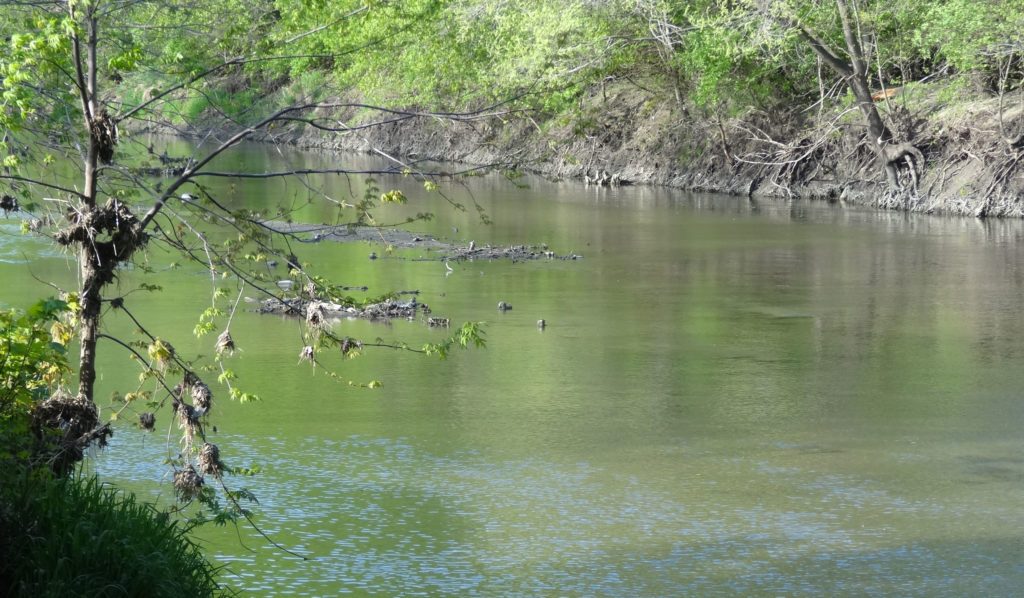 The comprehensive study also reveals key patterns in nitrate, phosphorus, and sediment pollution. For example, although there is more precipitation in summer, river flows and nutrient levels are at their highest in winter and spring, when there are fewer plants to help prevent erosion and absorb nutrients. In fact, the five largest river flow events in a watershed carry more than half of the nutrients that run off it each year.
The comprehensive study also reveals key patterns in nitrate, phosphorus, and sediment pollution. For example, although there is more precipitation in summer, river flows and nutrient levels are at their highest in winter and spring, when there are fewer plants to help prevent erosion and absorb nutrients. In fact, the five largest river flow events in a watershed carry more than half of the nutrients that run off it each year.
“A wet year in terms of nutrient loading is defined by large storm events,” said Markus. “More precipitation, on average, in a given year doesn’t necessarily lead to an increase in pollution. The increase is tied to heavy precipitation.”
The consensus of climate models shows that by mid-century in northern Illinois, there may well be a 15-30 percent increase in intensity and frequency of heavy storms.
For Illinois EPA, IDOA, and others charged with implementing the state’s nutrient strategy and reducing nutrient loading to the Gulf by 45 percent, these findings could lead to a more accurate understanding of the impact of their efforts. Farmers, city officials, and wastewater treatment plants across the Prairie State have been ramping up practices that reduce nitrogen and phosphorus loss since the state began work on the strategy in 2012.
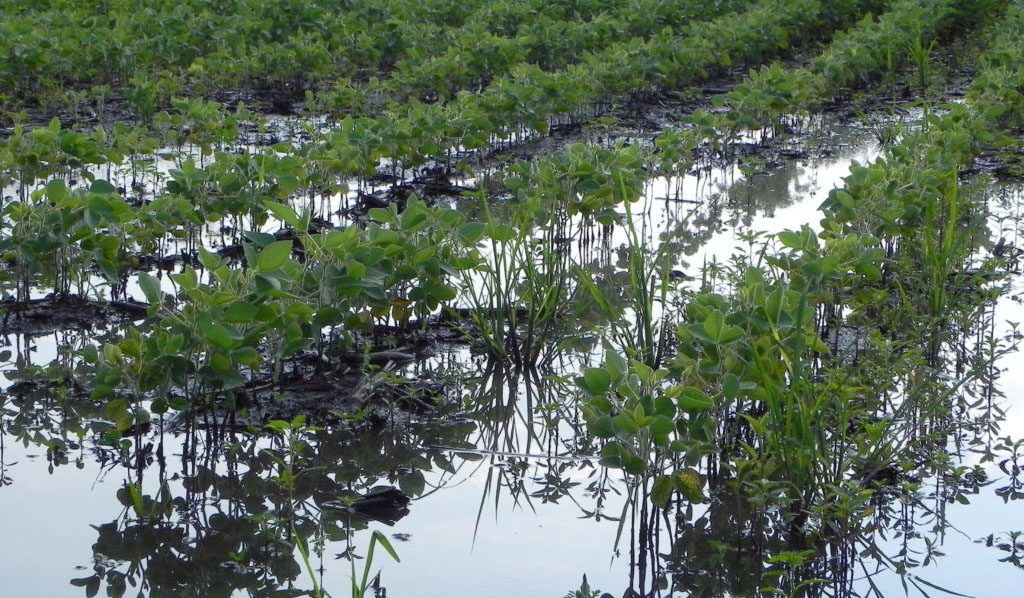 At the same time, government agencies, university researchers, and others are keeping an eye on the amount of nutrients leaving the state to help determine whether current strategy practices are enough to reach reduction goals. Understanding the critical role high-intensity storms play in nutrient loads could help ensure the value of these efforts isn’t obscured by a wet year. And knowing that these types of storms will be more frequent gives the state lead time to adapt strategy practices to the changing climate.
At the same time, government agencies, university researchers, and others are keeping an eye on the amount of nutrients leaving the state to help determine whether current strategy practices are enough to reach reduction goals. Understanding the critical role high-intensity storms play in nutrient loads could help ensure the value of these efforts isn’t obscured by a wet year. And knowing that these types of storms will be more frequent gives the state lead time to adapt strategy practices to the changing climate.
“What we design today, may not be sufficient in the future,” said Markus. “We can speculate that there will be more pollution, so management strategies that work today may not down the road.”
Anjanette Riley is a contributing author.
Illinois-Indiana Sea Grant is a part of University of Illinois Extension and Purdue University Extension.
April 4th, 2016 by iisg_superadmin
Think about “weather” as the clothes you are wearing on any given day. “Climate,” on the other hand, is all the clothes in your closet.
Molly Woloszyn’s metaphor helps visitors at the Peggy Notebaert Nature Museum understand how today’s weather does not really tell us what is happening in terms of climate and climate change. It’s the first of many lessons and activities i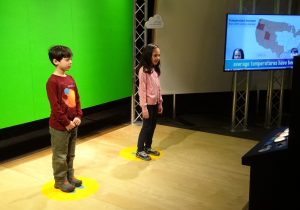 n the exhibit Weather to Climate: Our Changing World, which opened on Saturday.
n the exhibit Weather to Climate: Our Changing World, which opened on Saturday.
The exhibit provides many hands-on ways to understand weather, climate, and climate change. For example, using a weather simulator, you can mix ingredients like wind, humidity, cloud cover and more to whip up a thunder storm or a tornado—or a sunny day, if you are so inclined. And visitors can stand in front of the green screen and try their hand at being an on-air meteorologist.
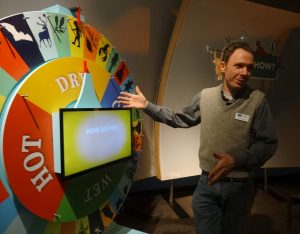 With the spin of a wheel, visitors can learn the impact of various climate scenarios on a variety of plants and animals, and they can create crazy new animals to cope with what may lie ahead. The exhibit journey wraps up with an opportunity to learn steps we can take to reduce our carbon footprint.
With the spin of a wheel, visitors can learn the impact of various climate scenarios on a variety of plants and animals, and they can create crazy new animals to cope with what may lie ahead. The exhibit journey wraps up with an opportunity to learn steps we can take to reduce our carbon footprint.
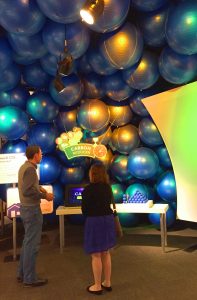 Woloszyn, IISG climate Extension specialist, who provided ideas and expertise to the exhibit development process, was on hand last week, along with Peggy Notebaert’s Steve Sullivan (pictured above) and Marc Miller to meet with reporters and introduce the exhibit.
Woloszyn, IISG climate Extension specialist, who provided ideas and expertise to the exhibit development process, was on hand last week, along with Peggy Notebaert’s Steve Sullivan (pictured above) and Marc Miller to meet with reporters and introduce the exhibit.
“The exhibit gives children and their caretakers a fun and interactive way to learn about weather, climate, and climate change–complex topics that are hopefully made easier to understand,” said Woloszyn (pictured below being interviewed). “The goal was to not only communicate the science and impacts on nature and humans, but to leave people with action they can take that can help our world by reducing their own carbon footprint.”
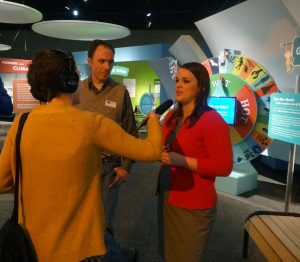
February 2nd, 2016 by iisg_superadmin
Illinois-Indiana Sea Grant is now a NOAA Weather-Ready Nation Ambassador as part of a national effort to improve the readiness, responsiveness, and overall resilience regarding extreme weather, water, and climate events.
The Weather-Ready Nation (WRN) initiative was formed in 2011 in response to deadly tornadoes that struck Joplin, Missouri and Birmingham, Alabama. At that point, the National Weather Service realized the need to better understand how to motivate people to respond to warnings.
 The goal of WRN is to save lives and livelihoods by providing better information for better decisions. NOAA is directing research to focus on improving scientific understanding of severe weather, developing new technologies, improving models, as well as addressing sociological challenges that may improve the likelihood people will take prompt action to save lives when they receive a warning.
The goal of WRN is to save lives and livelihoods by providing better information for better decisions. NOAA is directing research to focus on improving scientific understanding of severe weather, developing new technologies, improving models, as well as addressing sociological challenges that may improve the likelihood people will take prompt action to save lives when they receive a warning.
One groundbreaking WRN technological development is Wireless Emergency Alerts. Since 2012, these weather warnings go directly to WEA-capable cellphones—no sign up required. These alerts saved lives during the November 2013 tornado outbreak in Illinois.
The WRN plan involves the collective effort of the whole community, including other government agencies and emergency management, academia, the media, the insurance industry, non-profits, and the private sector. That’s where ambassadors come in.
Ambassadors are charged with being agents for change and leadership in a community—promoting WRN messages, engaging NOAA in potential collaborations, sharing success stories, and serving as an example by initiating workplace preparedness.
“Weather Ready Nation is a very important initiative for our country and I am happy that Illinois-Indiana Sea Grant is now a recognized ambassador,” said Molly Woloszyn, IISG Extension climate specialist. “A lot of the work that we do directly relates to the goals of the initiative, so this is a good opportunity to recognize that and to continue to explore how we can incorporate WRN and the National Weather Service into our efforts.”
Through Resilient Chicago, Woloszyn provides information for decision makers in the region to incorporate climate adaptation in local planning efforts. She is also leading a study to help critical facilities in Chicago, like hospitals, to assess their vulnerability to flooding and to adopt changes that reduce the risks.


 The comprehensive study also reveals key patterns in nitrate, phosphorus, and sediment pollution. For example, although there is more precipitation in summer, river flows and nutrient levels are at their highest in winter and spring, when there are fewer plants to help prevent erosion and absorb nutrients. In fact, the five largest river flow events in a watershed carry more than half of the nutrients that run off it each year.
The comprehensive study also reveals key patterns in nitrate, phosphorus, and sediment pollution. For example, although there is more precipitation in summer, river flows and nutrient levels are at their highest in winter and spring, when there are fewer plants to help prevent erosion and absorb nutrients. In fact, the five largest river flow events in a watershed carry more than half of the nutrients that run off it each year. At the same time, government agencies, university researchers, and others are keeping an eye on the amount of nutrients leaving the state to help determine whether current strategy practices are enough to reach reduction goals. Understanding the critical role high-intensity storms play in nutrient loads could help ensure the value of these efforts isn’t obscured by a wet year. And knowing that these types of storms will be more frequent gives the state lead time to adapt strategy practices to the changing climate.
At the same time, government agencies, university researchers, and others are keeping an eye on the amount of nutrients leaving the state to help determine whether current strategy practices are enough to reach reduction goals. Understanding the critical role high-intensity storms play in nutrient loads could help ensure the value of these efforts isn’t obscured by a wet year. And knowing that these types of storms will be more frequent gives the state lead time to adapt strategy practices to the changing climate. n the exhibit Weather to Climate: Our Changing World, which opened on Saturday.
n the exhibit Weather to Climate: Our Changing World, which opened on Saturday. With the spin of a wheel, visitors can learn the impact of various climate scenarios on a variety of plants and animals, and they can create crazy new animals to cope with what may lie ahead. The exhibit journey wraps up with an opportunity to learn steps we can take to reduce our carbon footprint.
With the spin of a wheel, visitors can learn the impact of various climate scenarios on a variety of plants and animals, and they can create crazy new animals to cope with what may lie ahead. The exhibit journey wraps up with an opportunity to learn steps we can take to reduce our carbon footprint. Woloszyn, IISG climate Extension specialist, who provided ideas and expertise to the exhibit development process, was on hand last week, along with Peggy Notebaert’s Steve Sullivan (pictured above) and Marc Miller to meet with reporters and introduce the exhibit.
Woloszyn, IISG climate Extension specialist, who provided ideas and expertise to the exhibit development process, was on hand last week, along with Peggy Notebaert’s Steve Sullivan (pictured above) and Marc Miller to meet with reporters and introduce the exhibit.

